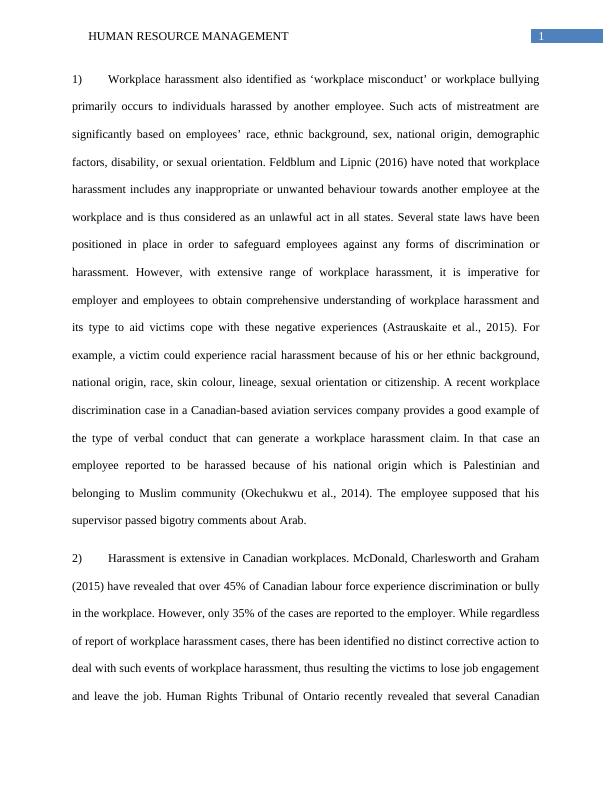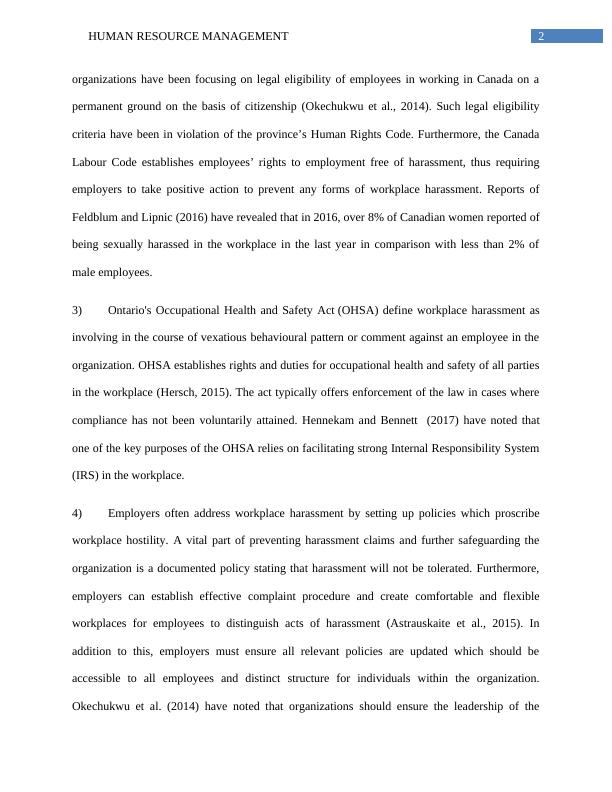Workplace Harassment and Discrimination: A Critical Analysis
Added on 2023-04-05
6 Pages1360 Words72 Views
Running head: HUMAN RESOURCE MANAGEMENT
HUMAN RESOURCE MANAGEMENT
Name of the Student:
Name of the University:
Author note:
HUMAN RESOURCE MANAGEMENT
Name of the Student:
Name of the University:
Author note:

1HUMAN RESOURCE MANAGEMENT
1) Workplace harassment also identified as ‘workplace misconduct’ or workplace bullying
primarily occurs to individuals harassed by another employee. Such acts of mistreatment are
significantly based on employees’ race, ethnic background, sex, national origin, demographic
factors, disability, or sexual orientation. Feldblum and Lipnic (2016) have noted that workplace
harassment includes any inappropriate or unwanted behaviour towards another employee at the
workplace and is thus considered as an unlawful act in all states. Several state laws have been
positioned in place in order to safeguard employees against any forms of discrimination or
harassment. However, with extensive range of workplace harassment, it is imperative for
employer and employees to obtain comprehensive understanding of workplace harassment and
its type to aid victims cope with these negative experiences (Astrauskaite et al., 2015). For
example, a victim could experience racial harassment because of his or her ethnic background,
national origin, race, skin colour, lineage, sexual orientation or citizenship. A recent workplace
discrimination case in a Canadian-based aviation services company provides a good example of
the type of verbal conduct that can generate a workplace harassment claim. In that case an
employee reported to be harassed because of his national origin which is Palestinian and
belonging to Muslim community (Okechukwu et al., 2014). The employee supposed that his
supervisor passed bigotry comments about Arab.
2) Harassment is extensive in Canadian workplaces. McDonald, Charlesworth and Graham
(2015) have revealed that over 45% of Canadian labour force experience discrimination or bully
in the workplace. However, only 35% of the cases are reported to the employer. While regardless
of report of workplace harassment cases, there has been identified no distinct corrective action to
deal with such events of workplace harassment, thus resulting the victims to lose job engagement
and leave the job. Human Rights Tribunal of Ontario recently revealed that several Canadian
1) Workplace harassment also identified as ‘workplace misconduct’ or workplace bullying
primarily occurs to individuals harassed by another employee. Such acts of mistreatment are
significantly based on employees’ race, ethnic background, sex, national origin, demographic
factors, disability, or sexual orientation. Feldblum and Lipnic (2016) have noted that workplace
harassment includes any inappropriate or unwanted behaviour towards another employee at the
workplace and is thus considered as an unlawful act in all states. Several state laws have been
positioned in place in order to safeguard employees against any forms of discrimination or
harassment. However, with extensive range of workplace harassment, it is imperative for
employer and employees to obtain comprehensive understanding of workplace harassment and
its type to aid victims cope with these negative experiences (Astrauskaite et al., 2015). For
example, a victim could experience racial harassment because of his or her ethnic background,
national origin, race, skin colour, lineage, sexual orientation or citizenship. A recent workplace
discrimination case in a Canadian-based aviation services company provides a good example of
the type of verbal conduct that can generate a workplace harassment claim. In that case an
employee reported to be harassed because of his national origin which is Palestinian and
belonging to Muslim community (Okechukwu et al., 2014). The employee supposed that his
supervisor passed bigotry comments about Arab.
2) Harassment is extensive in Canadian workplaces. McDonald, Charlesworth and Graham
(2015) have revealed that over 45% of Canadian labour force experience discrimination or bully
in the workplace. However, only 35% of the cases are reported to the employer. While regardless
of report of workplace harassment cases, there has been identified no distinct corrective action to
deal with such events of workplace harassment, thus resulting the victims to lose job engagement
and leave the job. Human Rights Tribunal of Ontario recently revealed that several Canadian

2HUMAN RESOURCE MANAGEMENT
organizations have been focusing on legal eligibility of employees in working in Canada on a
permanent ground on the basis of citizenship (Okechukwu et al., 2014). Such legal eligibility
criteria have been in violation of the province’s Human Rights Code. Furthermore, the Canada
Labour Code establishes employees’ rights to employment free of harassment, thus requiring
employers to take positive action to prevent any forms of workplace harassment. Reports of
Feldblum and Lipnic (2016) have revealed that in 2016, over 8% of Canadian women reported of
being sexually harassed in the workplace in the last year in comparison with less than 2% of
male employees.
3) Ontario's Occupational Health and Safety Act (OHSA) define workplace harassment as
involving in the course of vexatious behavioural pattern or comment against an employee in the
organization. OHSA establishes rights and duties for occupational health and safety of all parties
in the workplace (Hersch, 2015). The act typically offers enforcement of the law in cases where
compliance has not been voluntarily attained. Hennekam and Bennett (2017) have noted that
one of the key purposes of the OHSA relies on facilitating strong Internal Responsibility System
(IRS) in the workplace.
4) Employers often address workplace harassment by setting up policies which proscribe
workplace hostility. A vital part of preventing harassment claims and further safeguarding the
organization is a documented policy stating that harassment will not be tolerated. Furthermore,
employers can establish effective complaint procedure and create comfortable and flexible
workplaces for employees to distinguish acts of harassment (Astrauskaite et al., 2015). In
addition to this, employers must ensure all relevant policies are updated which should be
accessible to all employees and distinct structure for individuals within the organization.
Okechukwu et al. (2014) have noted that organizations should ensure the leadership of the
organizations have been focusing on legal eligibility of employees in working in Canada on a
permanent ground on the basis of citizenship (Okechukwu et al., 2014). Such legal eligibility
criteria have been in violation of the province’s Human Rights Code. Furthermore, the Canada
Labour Code establishes employees’ rights to employment free of harassment, thus requiring
employers to take positive action to prevent any forms of workplace harassment. Reports of
Feldblum and Lipnic (2016) have revealed that in 2016, over 8% of Canadian women reported of
being sexually harassed in the workplace in the last year in comparison with less than 2% of
male employees.
3) Ontario's Occupational Health and Safety Act (OHSA) define workplace harassment as
involving in the course of vexatious behavioural pattern or comment against an employee in the
organization. OHSA establishes rights and duties for occupational health and safety of all parties
in the workplace (Hersch, 2015). The act typically offers enforcement of the law in cases where
compliance has not been voluntarily attained. Hennekam and Bennett (2017) have noted that
one of the key purposes of the OHSA relies on facilitating strong Internal Responsibility System
(IRS) in the workplace.
4) Employers often address workplace harassment by setting up policies which proscribe
workplace hostility. A vital part of preventing harassment claims and further safeguarding the
organization is a documented policy stating that harassment will not be tolerated. Furthermore,
employers can establish effective complaint procedure and create comfortable and flexible
workplaces for employees to distinguish acts of harassment (Astrauskaite et al., 2015). In
addition to this, employers must ensure all relevant policies are updated which should be
accessible to all employees and distinct structure for individuals within the organization.
Okechukwu et al. (2014) have noted that organizations should ensure the leadership of the

End of preview
Want to access all the pages? Upload your documents or become a member.
Related Documents
MGMT1601 BUSINESS LAW ASSIGNMENTlg...
|6
|729
|175
Australian Human Rights Commission Case Study 2022lg...
|9
|1666
|49
Employment Law: Sexual Harassment at Workplacelg...
|13
|2902
|444
National Employment Law Project:lg...
|4
|664
|18
Sexual Harassment in Workplace Assignment pdflg...
|13
|3065
|329
Business Law Assignment Tasklg...
|5
|1049
|18
